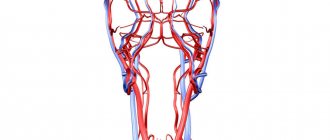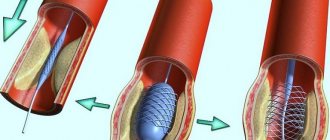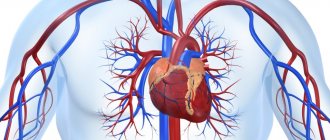Features of establishing disability in hypertension
A normal surge in blood pressure is not a reason to apply for a referral for examination. If cases of increased blood pressure recur, it is recommended to first identify the cause of this condition and undergo a course of treatment prescribed by a doctor.
In the case of even more frequent manifestations of the problem, as well as its duration, it is necessary to record the abnormal condition and establish temporary disability for the patient (usually we are talking about a certain period).
If the situation worsens, complications arise and important organs are involved in the process (brain, blood vessels, heart, etc.), it is necessary not only to reconsider the way of life and work, but also to think about assigning disability due to the person’s constant need for medications and the inability to work in the same place (for example, may prohibit hard work, etc.).
What documents are needed?
First of all, you need to contact your doctor. He will prescribe the necessary examinations and consultations with specialists.
- General blood and urine analysis.
- Urinalysis according to Nechiporenko.
- Biochemical blood test, sugar, ALT, AST, volume protein, creatinine, urea, cholesterol, triglycerides, lipid profile.
- ECG.
- X-ray of the chest organs.
- Echo KG.
- Holter monitoring ECG.
- ABPM.
- Ultrasound of the kidneys and blood vessels.
- Consultation with an ophthalmologist, surgeon, neurologist, ENT doctor.
After you have completed all the examinations and consultations, you must contact your local physician. Provide him with a complete list of your tests, recent hospital discharges, documents confirming the presence of hypertensive crises.
The therapist will ask you about the course of your disease and its duration, what symptoms are bothering you, and conduct a physical examination. Fill out form N088/у-06, after which you must contact the local ITU office, where you will be given an examination date.
Criteria for assigning a disability group
So, from the above it is clear that it is still possible to get disability due to hypertension. However, at the ITU, commission members take into account a number of criteria by which a specific group is given. In particular:
— 3 group
is established against the background of stage 2 hypertension, if the organs are not very badly affected and the disease proceeds under standard conditions, the person can work and lead a completely normal life with some restrictions;
— group 2
is assigned to those whose disease occurs in a malignant form (these are stages 2 or 3), while heart failure and internal damage are moderate, and the treatment gives an average effect and most often the patient is incapacitated;
— 1 group
is relevant for hypertension of the 3rd or 4th degree, if the disease progresses, is accompanied by obvious heart failure, severe internal disorders, lack of a positive result from treatment, limitations in life (difficult or impossible to care for oneself, communicate, etc.).
Which group can a hypertensive patient receive?
Is sick leave given for high blood pressure?
There are three disability groups in total – first, second and third.
The third disability group is assigned for a mild form of the disease, when the patient’s condition is not very critical and does not require assignment of disabled status. The working day for this form of disability by law cannot exceed 7 hours.
The second group is assigned to those patients in whom the malignant nature of the disease is determined, which does not require complete separation from the work process. Disabled people in this group are automatically prohibited from: working in premises where significant amounts of heat, vapors and gases are generated or at height, as well as working with complex mechanisms that require increased concentration.
The first group includes patients suffering from hypertension, accompanied by serious pathological changes in the functioning of vital organs and systems. Upon receipt of this disability group, the patient is recognized as incapable of work and is released from work.
The positive conclusion of the commission should be transferred to the patient within 3 working days to the pension fund at the place of residence, for the assignment of a disability pension
After receiving a conclusion about disability, the patient must, after a certain period of time, confirm the previously assigned group: for a disabled person of the first group - every two years, for the second and third - every year. Confirmation of disability is necessary, first of all, so that the commission can adequately assess the patient’s condition and, if necessary, assign the patient a different disability group or completely remove the disabled status from the person if he has recovered. However, not all disabled people need re-examination; some are exempt from it. These are: women who have reached the age of 55 and men after the age of 60, as well as those patients who have experienced any irreversible changes in the body due to hypertension.
Re-examination is a mandatory procedure. Missing it risks complete cancellation of the existing disability group for the patient and deprivation of corresponding payments and benefits.
No ads 2
Employment restrictions
Having the diagnosis and disability group in question, the beneficiary must understand that certain types of work may be contraindicated for him, for example:
- going out on the night shift;
- hard physical labor;
- long-term strong concentration of attention;
— “nervous” professions (manager, teacher, accountant, journalist, official, etc.);
- activity against a background of high temperature, high-frequency vibrations, radiation.
In general, first of all, in the hypertension group, you need to avoid any work in which there is a risk of harm to people and an emergency situation.
Can they refuse to grant disabled status?
Yes, in practice there are cases when, with constant elevated blood pressure, a socio-medical examination still refuses to grant disabled status. Most often this happens when a sick person applies for a third group of disability.
However, such refusals, just like the provision of an inappropriate disability group, can be easily challenged within one month by contacting the Main Bureau of Medical and Social Expertise of the region in which the examination was carried out. If this measure does not bring the desired result, then the patient is recommended to send a corresponding complaint to the main ITU body - the Federal Bureau or to the court.
Registration of disability for those suffering from hypertension is a rather complex process that requires considerable strength and perseverance. However, despite all the difficulties that arise along the way, a person with stage 2 or 3 hypertension should definitely be concerned with these issues and, having received the status of a disabled person, exercise their rights to social protection from the state.
Benefits for disabled people with hypertension
There are no additional preferences for the mentioned category of citizens in the law, that is, they are entitled to the same benefits that apply to other disabled people, depending on the group. Simply put, the state provides benefits and support in the form of:
— disability pensions;
— EDV — paid every month, consists of cash and a set of social services (the latter can be replaced with material compensation);
- reduced taxes or exemptions from them;
— refund up to 50% for utility bills;
— freely provided medicines, prostheses, equipment, etc.;
— free travel on public transport, or with the possibility of compensation;
— labor preferences, starting with a reduction in the working week, additional days of vacation and ending with hiring without a probationary period (more on this in the Labor Code of the Russian Federation).
Degrees of hypertension
Arterial hypertension can seriously damage internal organs and disrupt their functioning. The heart and blood vessels are especially affected by this disease. Constantly high blood pressure in a person requires special working conditions, which the employer is obliged to create for his employee.
The diagnosis of arterial hypertension is made to a patient whose blood pressure can regularly rise above 140/90 mmHg.
This situation already has a negative impact on a person’s health; he needs constant medical supervision and the prescription of antihypertensive medications.
Disorders in the body:
- Constriction of blood vessels occurs.
- Visual dysfunction.
- Disruption of the activity of the entire cardiovascular system, disruption of the heart rhythm, deterioration of blood supply to the left ventricle of the heart due to an increase in its mass.
- Disorder of renal activity due to high load on this organ.
- Rapid development of atherosclerotic lesions of the vessels of the brain, heart, and aorta.
With hypertension, various organs can suffer; doctors call them target organs. The attending physician assesses the risks of such a patient to determine whether he needs a disability group or whether the person is still fully able to work.
Symptoms of the disease can manifest themselves in different ways, depending on the extent of the pathological process. If the patient already has stage 3 of the disease, then obtaining disability for hypertension is not only possible, but also necessary. It is believed that people with such health problems should not work, since any load is fraught with dangerous consequences. In stage 1 of the disease, the issue of disability or limitation of work activity is decided separately, in each specific situation.
Hypertension is believed to develop gradually, so doctors classify the disease into degrees or stages. The onset of the disease can usually occur unnoticed by a person, but this does not mean that it is without consequences for health. However, with arterial hypertension of the 1st degree, the risk of serious disorders of the body is minimal, but the creation of favorable working conditions is necessary, so the doctor may send such a patient for a medical examination.
Features of stage 1 disease:
- Pressure increases periodically.
- No heart damage has yet been observed.
- The person’s ability to work has been preserved.
Manifestations of the disease with this course of the disease are weak. People feel unwell only during periods of high blood pressure.
Symptoms of stage 1 disease:
- pain in the head, which intensifies with physical activity;
- increased heart rate;
- noise in ears;
- mild aching pain in the left side of the chest, which can radiate to the shoulder blade;
- flickering of flies before the eyes.
The disability group for hypertension of the 1st degree is not assigned, since the symptoms occur from time to time and are not considered severe. However, we must not forget that the disease can progress, so you need to constantly monitor your health. Such patients need improved working conditions. Noise, vibration and night shifts are contraindicated for hypertensive patients, even if the pathology is only at the initial stage of development.
Is it possible to give disability for 2nd degree hypertension? It is impossible to answer this question unequivocally; the decision is made by a commission.
This stage of the disease is characterized by a regular increase in pressure within 180/110 mmHg. Art.
Features of stage 2 disease:
- Damage to target organs; conditions associated with this.
- Heart rhythm disorder.
- Violation of cardiac activity and damage to the muscle tissue of the organ.
- Vascular thrombosis.
Disability with this course of the disease is quite real, since the degree of risk in the second stage of hypertension can reach up to 4. It all depends on concomitant pathologies - often diabetes mellitus, severe damage to blood vessels and internal organs. The person’s condition is considered serious, since the symptoms are pronounced.
Symptoms of stage 2 disease:
- feeling of constant fatigue;
- increased sweating;
- redness of the skin, especially the face, due to hyperemia;
- swelling of tissues due to kidney damage;
- vision deviations;
- nausea;
- tremor of the upper extremities;
- hypertensive crisis that occurs frequently.
The symptoms of this stage of the disease can be different, since high pressure disrupts the functioning of many organs. Doctors regard this condition as serious, and usually patients with stage 2 hypertension are considered disabled.
Special working conditions for this category of people must be observed.
Activity restrictions:
- Work in hot shops.
- Reducing workload that requires high concentration.
- Prohibition on activities with increased emotional, physical and mental stress.
- Reduced overall operating time.
This disease requires constant treatment and monitoring, as it quickly progresses to stage 3.
Stage 3 hypertension can be considered the most dangerous form of this disease, since a lot of disorders occur in the body, which creates risk 4 - a high degree of possible destruction of organs and body systems. The third stage of the disease occurs with pronounced symptoms, which include a general deterioration in health and severe pain in the heart.
Patients with this stage of the disease are usually recognized as completely incapacitated, so they should be given disability status. However, the important question remains about the group. Some patients may be considered partially able to work and are allowed to work in improved conditions or at home.
Only specialists working in the bureau of medical and social examination decide which disability group a particular person is entitled to for hypertension, and only after a thorough check this patient will receive it.
How can a hypertensive patient get disability?
1. Necessary examinations
An applicant for special status must carry out a number of procedures and undergo tests, more precisely:
- do a general blood and urine test;
— donate blood to assess cholesterol, sugar levels, etc.;
- have ultrasound data of the abdominal cavity, kidneys, arteries;
— get the results of echocardiography, electrocardiogram;
- check your eyesight.
Important
! Additional manipulations can be prescribed individually to create the most complete clinical picture.
2. Procedure for processing documents
After registering with a specialized specialist, you will need to monitor how hypertension develops. The doctor records all the data in the medical record. This is necessary so that in the future it can be proven that the patient needs to establish a group.
If the condition does not stabilize or improve for a long time, the specialist begins preparing documents for the ITU. A hypertensive patient with a bypass sheet visits doctors related to his illness and receives conclusions. As a result, the attending physician issues a referral for examination.
Next, you need to collect a package of documents and attach them to the issued direction:
— patient’s passport (and copy), SNILS;
— application to the ITU in the prescribed form;
— a certificate about the conditions in which a disabled person works;
- characteristics from the educational institution (for students);
— a copy of the work book certified by a personnel employee;
— originals of certificates, doctor’s notes, etc., confirming the complexity of the condition;
— copies of previously issued ITU conclusions (if the commission is not the first).
3. Passing the ITU
Here we outline the key points:
— the date of examination will be set upon provision of the necessary documents (as a rule, you don’t have to wait longer than a month);
— during the examination, 3 experts examine the patient, ask questions (questions relate to different areas of life) and form a conclusion based on the protocol;
— an independent specialist can be invited to the commission, and within the framework of the procedure he will be endowed with the same rights as members of the ITU Bureau;
— now it is possible to obtain a disability without personal presence only taking into account the documents provided, but the preference of an absentee examination is available for citizens living in difficult-to-reach areas or in other exceptional cases;
- most disabled people receive a group for a year (usually groups 3 and 2) or for several years (group 1), and after the specified period they need to go through the commission again, but in difficult situations they give indefinite status.
How is the status of a disabled person registered?
To obtain the status of a disabled person, the patient will need to send a corresponding application for registration of disability to the head of the medical institution in which he is being observed, and on its basis receive a referral to undergo a medical and social examination. The latter implies all kinds of diagnostic and laboratory tests, as well as examination by various medical specialists.
Conducting a medical and social examination is possible both in an inpatient setting and on an outpatient basis and even in absentia without the presence of the patient
After passing the examination, a specially assembled commission, having studied the documents about the patient’s condition: his medical history, as well as additional information about the previous treatment and its results, by closed vote assigns the patient a certain disability group based on the above data. It is worth noting that in addition to the medical history and certificate of the course of the disease, the patient must also attach the results of clinical studies to the main package of documents:
- Blood tests - general analysis and collection to determine cholesterol levels.
- Zimnitsky urine test.
- Electrocardiogram.
- Ophthalmologist's report.
- As well as ultrasound of the kidneys, heart and other internal organs.
No ads 1
Does arterial hypertension cause disability?
Hypertensive patients are advised to register at the dispensary and undergo regular medical examinations. This is necessary to monitor health status and the development of target organ damage. In the absence of contraindications, patients receive vouchers for sanatorium treatment. And data on the results of treatment are recorded in the patient’s personal card. They are submitted to the expert commission to determine disability.
Assignment of disability depends on the degree of hypertension, complications, general physical and psychological well-being.
- Types of arthrosis and their degrees for which a disability group is given
What does disability give?
Disability is the status of an individual, which is acquired in connection with deviations in his state of health, accompanied by a persistent disorder of body functions due to illness or injury. The law established a list of diseases for which the status of a disabled person is granted, and the rules for obtaining it. The status of a disabled person makes it possible to receive support measures established by the state - cash payments, free medicines, tax, labor or other benefits.
| Support measure | Characteristics | Base |
| Pension provision | Insurance part of the pension (if you have even 1 day of service without reference to age) | Art. 9 Federal Law No. 400-FZ dated December 28, 2013 |
| Social pension (in the absence of grounds for assigning insurance) | Art. 11 Federal Law No. 166-FZ dated December 15, 2001 | |
| EDV | Indexed annually. Installed when refusing a set of social services. The payment amount is:
| Art. 28.1 Federal Law No. 181-FZ dated November 24, 1995 |
| Set of social services | Prescription medications, sanatorium-resort vouchers by referral, travel by suburban or intercity transport to the place of treatment and back | Art. 6.1 Federal Law No. 178-FZ dated 17.97.1999 |
| In the world of work | Shortened working week - 35 hours (for grades I and II) | Art. 92 Labor Code of the Russian Federation |
| Length of working day, shifts according to medical indications | Art. 94 Labor Code of the Russian Federation | |
| Admission to night and overtime work only with the consent of the disabled person | Art. 96, 99 Labor Code of the Russian Federation | |
| Work on weekends and holidays in the absence of medical prohibitions | Art. 113 Labor Code of the Russian Federation | |
| Vacation at your own expense up to 60 calendar days per year at a time convenient for the disabled person | Art. 128 Labor Code of the Russian Federation | |
| In the field of education | Admission to universities according to a quota (disabled people of grades I and II, from childhood, with war trauma) | Art. 71 Federal Law No. 273-FZ dated December 29, 2012 |
| In the field of employment | Employer quotas for jobs | Federal Law No. 181-FZ |
| Tax | Deduction in the amount of 500 rubles. for each month of the calendar year in terms of income that is subject to personal income tax | Art. 224 Tax Code of the Russian Federation |
| Reduction of the tax base for land tax by the cadastral value of 600 m² of land area owned by a disabled person since childhood | Art. 391 Tax Code of the Russian Federation | |
| Exemption of disabled people from childhood from property tax (in part 1 of each type of taxation object) | Art. 407 Tax Code of the Russian Federation |
Labor restrictions for hypertension
Thus, if you have been diagnosed with arterial hypertension, this does not mean that you will immediately receive a disability group. At the same time, with such a diagnosis, you need easier working conditions. If you have stage 1 hypertension, you have the right to the following improvements in working conditions:
- work should not lead to severe stress;
- performance of work should not be accompanied by strong vibration or noise;
- night work should be replaced by day shifts;
- During work there should be no contact with vascular poisons.
Hypertension of the 2nd degree implies even greater restrictions on the patient’s work. Thus, with stage 2 hypertension, you cannot engage in work activities that:
- requires constant exertion of physical and emotional strength;
- associated with height, moving mechanisms, hot shops.
In addition, a hypertensive patient diagnosed with stage 2 hypertension should be able to work part-time, as well as perform reduced amounts of work that requires close attention and great stress.
The last stage of the disease is the most acute, and no matter what treatment methods are used, they will not differ in effectiveness
In stage 3 hypertension, only certain individuals, according to medical indicators, can have partial ability to work and engage in work in especially improved conditions or at home.
With all this, hypertensive patients must be registered, regularly examined, and undergo the courses of treatment indicated for them, including sanatorium-preventive ones.
Instructions: how to apply for disability
New rules for obtaining disability have made the examination procedure simpler. Now the medical organization independently transmits the referral to the ITU electronically; citizen participation in the process is not necessary. The procedure became possible with the adoption of Government Resolution No. 607 of May 16, 2019. The Ministry of Labor of the Russian Federation, in letter No. 13-4/10/B-4132 dated May 29, 2019, explained the provisions of the new regulatory act.
Let's look at getting disability in 2021 step by step, taking into account the new rules.
Step 1. Receive a referral to ITU or a certificate of refusal to be sent to ITU.
A referral, subject to the consent of the person in writing, is issued:
- by a medical institution upon implementation of a set of measures, despite which persistent impairment of body functions persists;
- Pension Fund or social security - in the presence of documents that confirm deviations in functions due to illness, injuries, defects.
The referral to the ITU is transmitted to one of the specified organizations via electronic communication channels, or, if there are none, on paper.
Upon receipt of a refusal, a person is issued a certificate, in the presence of which he applies to the ITU independently.
Step 2. Prepare the required documents.
The following documents are required to complete the procedure:
- consent of the person in writing to conduct MSE;
- ID card or its certified copy;
- document proving the identity and authority of the representative (if the application is made through a representative);
- referral to ITU or certificate of refusal in such a referral;
- application for an ITU (when a citizen is issued a certificate of refusal to be referred to an ITU);
- medical documents that make it possible to establish the causes of disability;
- medical documents to determine the degree of loss of ability to work;
- conclusion of the medical commission of a medical organization confirming that for health reasons the citizen is not able to come to the MSA office, and therefore he requires MSA at home.
Step 3. Wait for the invitation to the ITU.
There is no longer any need to contact ITU. After receiving documents from the medical organization, the ITU sends an invitation to the patient, which indicates the date, time, and place of the examination.
Step 4. Go through the ITU and get a solution.
ITU pass:
- at the ITU bureau at the place of residence (place of stay), location of the pension case;
- at home if it is impossible to attend due to health;
- in a medical institution where the person is hospitalized;
- in the organization of inpatient social services;
- in a correctional facility;
- in absentia - by decision of the bureau.
Step 5. Obtain a certificate of disability and IPR.
A certificate confirming the established disability and IPR (rehabilitation program) is sent to:
- by registered mail;
- through the government services portal.











